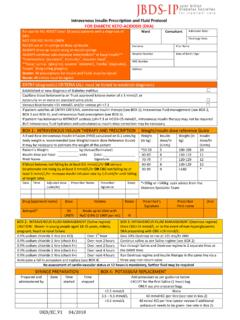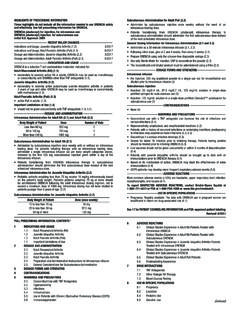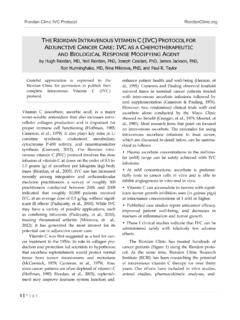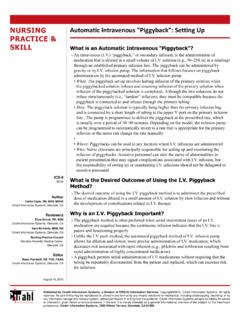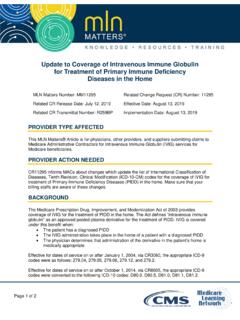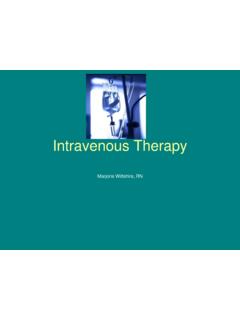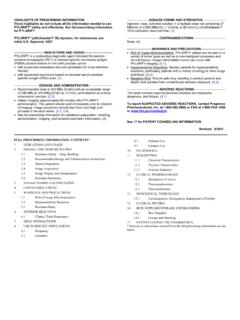Transcription of The use of variable rate intravenous insulin infusion ...
1 The use of variable rate intravenousinsulin infusion (VRIII) in medicalinpatientsOctober 2014 This document is coded JBDS 09 in the series of JBDS documents: Other JBDS documents:Management of Hyperglycaemia and Steroid (Glucocorticoid) Therapy October 2014 JBDS 08 Admissions avoidance and diabetes: guidance for clinical commissioning groups and clinical teamsDecember 2013 JBDS 07 The management of the hyperosmolar hyperglycaemic state (HHS) in adults with diabetes August2012 JBDS 06 Glycaemic management during the inpatient enteral feeding of stroke patients with diabetes June2012 JBDS 05 Self-Management of Diabetes in Hospital March 2012 JBDS 04 Management of adults with diabetes undergoing surgery and elective procedures.
2 Improvingstandards April 2011 JBDS 03 The Management of Diabetic Ketoacidosis in Adults Revised September 2013 JBDS 02 The Hospital Management of Hypoglycaemia in Adults with Diabetes Mellitus Revised September2013 JBDS 01 These documents are available to download from the ABCD website and the Diabetes UK website are eager to find out about your experiences using this guideline- particularly any datafrom audits of its use in situ. This will be used in the next update of the guideline. Pleasecontact Dr Stella George at: guideline is for the use of a variable rate intravenous insulin infusion (VRIII) in adult inpatients with medicalconditions and diabetes/hyperglycaemia, who require intravenous administration of insulin to keep their bloodglucose within the recommended target range during an acute illness or a period of starvation.
3 This guideline is not suitable for use in certain situations. We make the followingrecommendations for those circumstances. Scope of the guidelineThis document is designed to guide non specialist teams in the appropriate and safe use of a help from your local diabetes team at the earliest Ketoacidosis (DKA)The management of DKA in Adults [JBDS 02; March 2012, revised June 2013] hyperglycaemic State (HHS)The management of the hyperosmolar hyperglycaemic state [JBDS 06; August 2012] Patients who are perioperative or are undergoing Management of adults with diabetes undergoingprocedures requiring a period of starvation surgery and elective procedures: improving standards [JBDS 03; April 2011] currently being who require enteral feeding who Glycaemic management during the inpatient enteralhave suffered a strokefeeding of stroke patients with diabetes[JBDS 05.]
4 June 2012] Coronary SyndromeUse local guideline Patients requiring Total Parenteral NutritionUse local guidelineAntenatal patientsUse local guidelinePatients who are hyperglycaemic due to steroid Use local guideline- JBDS guideline in developmenttherapy4 Abbreviations used in this guidelineTermAbbreviationVariable rate intravenous insulin infusion VRIIIC apillary blood glucoseCBGD iabetic KetoacidosisDKAH yperosmolar Hyperglycaemic StateHHST otal Parenteral NutritionTPNC ontinuous Subcutaneous insulin InfusionCSIIT otal Daily DoseTDDS odium ChlorideNaClPotassium ChlorideKClNational Institute of Clinical ExcellenceNICELead authorshipDr Stella George, Consultant Diabetes and Endocrinology, East and North Hertfordshire NHS TrustDebbie Stanisstreet, Diabetes Inpatient Specialist Nurse, East and North Hertfordshire NHS TrustSupporting organisationsDiabetes UK: Tracy Kelly, Head of CareJoint British Diabetes Societies (JBDS) for Inpatient Care, Chair: Professor Mike Sampson (Norwich)Diabetes Inpatient Specialist Nurse (DISN) UK Group, Chair: Esther Walden (Norwich)Association of British Clinical Diabetologists (ABCD), Chair.
5 Dr Rob Gregory (Leicester)Endorsed byDiabetes FrailThe Diabetes Management and Education Group (DMEG) of the British Dietetic AssociationRoyal College of Physicians (RCP)The Renal AssociationThe Society for Acute Medicine (SAM)UK Clinical Pharmacy Association (UKCPA) Diabetes and Endocrinology CommitteeWriting groupDr Ali Abbara, Imperial Healthcare College NHS TrustLinda Balian, Yeovil District Hospital NHS Foundation TrustDr Mithun Bhartia, Sandwell and West Birmingham Hospitals NHS TrustAlison Cox, Kings College Hospital NHS Foundation TrustDr Frances Coyle, Frimley Park Hospital NHS Foundation TrustAnne Currie, East and North Hertfordshire NHS TrustDr Jane Dale, The Dudley Group NHS Foundation TrustDr Ketan Dhatariya, Norfolk and Norwich University Hospitals NHS Foundation TrustDr Philip Dyer, Heart of England NHS Foundation TrustDr Haleema Hayat, Burton Hospitals NHS Foundation TrustDr Anne Kilvert, Northampton General Hospital NHS TrustDr Abbi Lulsegged.
6 Kings College Hospital NHS Foundation TrustDr Samson Oyibo, Peterborough and Stamford Hospitals NHS TrustTobi Parkin, Northern Devon Healthcare NHS Trust56 JBDS IP GroupDr Belinda Allan, Hull and East Yorkshire Hospital NHS TrustDr Hamish Courtney, Belfast Health and Social Care Trust, Northern IrelandDr Ketan Dhatariya, Norfolk and Norwich University Hospitals NHS Foundation TrustDr Daniel Flanagan, Plymouth Hospitals NHS TrustDr Stella George, East and North Hertfordshire NHS TrustDr Rob Gregory, University Hospitals of Leicester NHS TrustJune James, University Hospitals of Leicester NHS TrustTracy Kelly, Diabetes UKDr Rif Malik, King s College Hospital NHS Foundation TrustDr Colin Perry, NHS Greater Glasgow and ClydeDr Gerry Rayman, The Ipswich Hospitals NHS TrustDr Stuart Ritchie, NHS LothianDr Aled Roberts, Cardiff and Vale University Health BoardProfessor Mike Sampson (Norwich), Chair, Joint British Diabetes Societies (JBDS)
7 For Inpatient Care Dr Maggie Sinclair-Hammersley, Oxford University Hospitals NHS TrustDebbie Stanisstreet, East and North Hertfordshire NHS TrustProfessor Jonathan Valabhji, National Clinical Director for Obesity and DiabetesEsther Walden, Norfolk and Norwich University Hospital NHS Foundation TrustDr Peter Winocour, East and North Hertfordshire NHS TrustWith special thanks to Christine Jones for her administrative work and help with these guidelines and withJBDS IP7 PageForeword9 Introduction10 Chapter 1: Background and Definition of variable rate intravenous insulin Classification of hyperglycaemia in acutely unwell The use of VRIII in UK The National Diabetes Inpatient Dynamic Sliding Scale intravenous insulin Regimes Combined Glucose, Potassium, insulin infusion Regimes 12 Chapter 2.
8 Evidence base for Evidence for adverse effect of hyperglycaemia on 13outcomes during illness Evidence for specific blood glucose Glycaemic control in intensive care Glycaemic control in hospitalised patients in non ICU Glycaemic control in acute myocardial infarction Glycaemic control in Guidelines from national and international Summary of Evidence17 Chapter 3: Recommendations for use of Indications for VRIII in medical Advantages of a Disadvantages of a Potential risks of a Practical aspects of setting up a VRIII Setting up a VRIII Suggested infusion rates Treatment of Hypoglycaemia during a Maintaining safety during the use of a VRIII Frequency of measurement and targets for capillary21-23blood glucose monitoring Measurement of capillary blood ketones Frequency of clinical patient Choice of concurrent fluids Factors affecting the choice of fluid and rate of infusion Recommended fluid
9 Duration of VRIII Management of other diabetes medications during a VRIII Transferring from a VRIII to subcutaneous insulin and/or oral25treatment Safe use of insulin 26 Chapter 4: Special Patients on total parenteral Delivery Cautions27 Stepping down from a VRIII in patients on total 27parenteral Patients on continuous subcutaneous infusion pumps27-28 AppendicesAppendix 1: How to set up a VRIII29 Appendix 2: Safe discontinuation of a VRIII 30-38 Appendix 3: Management of hyper and hypoglycaemia39-40 following discontinuation of the VRIIIA ppendix 4: Quick reference tool for the use of a VRIII41-43 References44-479It is recognised that the use of a variable rate intravenous insulin infusion (VRIII) is a tool commonly usedto achieve normoglycaemia in hospital inpatients.
10 Most acute trusts have guidelines for its use, but there is a wide variation across the country in, forexample, the indications for its use, in rates of infusion , or duration of use. This heterogeneity increasesthe risk of errors which can potentially lead to significant morbidity and mortality. It also makes itinherently difficult to study its efficacy, optimisation and safety profile. In addition, despite guidelines, bothlocal and national audits have shown that VRIII is often used when not indicated, its duration isunnecessarily prolonged and the step down to other glucose lowering medication is often not practicedsafely. It is also acknowledged that achieving optimal glycaemia in this group of often complex patients, is noteasy to achieve and individual targets are often needed.
